|
Related FAQs: Poritids, FAQs 2, FAQs 3, Poritid Identification, Poritid Behavior, Poritid Compatibility, Poritid Selection, Poritid Systems, Poritid Feeding, Poritid Health, Poritid Reproduction/Propagation,
Stony/True Coral, Coral System Set-Up, Coral System Lighting, Stony Coral Identification, Stony Coral Selection, Coral Placement, Foods/Feeding/Nutrition, Disease/Health, Propagation, Growing Reef Corals, Stony Coral Behavior, SPS Identification, SPS Behavior, SPS
Compatibility, SPS Selection,
SPS Systems, SPS Feeding, SPS
Disease, SPS
Reproduction,
Related Articles: Poritid Corals, Stony or True Corals, Order
Scleractinia
Genera Coverage: Alveopora, Goniopora,
/The Best Livestock For Your Reef Aquarium:
Genus Porites, Family
Poritidae
Part 2 of 4
To: Porites 1, Porites 3,
Porites 4,
|
|
|
By Bob Fenner
|
|
| Porites attenuata Nemenzo 1955. /COTW:
Characters: Colonies
are sturdy fused branches with rounded tips. Corallites are moderately
excavated. The coenosteum is coarse.
Colour: Usually
mustard or bright yellow-green, also pale brown.
Similar Species: Porites
cylindrica, which has finer branches and less excavated corallites.
See also P.
tuberculosa.
Habitat: Shallow
protected reef environments.
Abundance: Common.
N. Sulawesit pic.
|
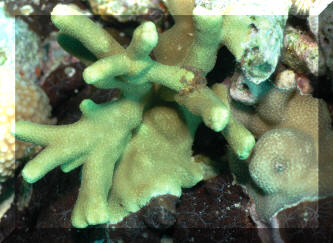 |
| Porites branneri.
Blue Crust Coral. Colonies to half a foot in diameter. Appear blue to
purple. Small, pitted corallites.
St Thomas 2014 |
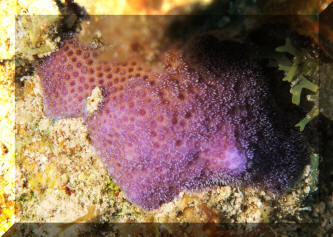 |
Bigger PIX:
The images in this table are linked
to large (desktop size) copies. Click on "framed" images
to go to the larger size. |
|
|
| Porites californica, Emerald Coral. Bright green in
shallow to darkening brown w/ depth. Polymorphic: encrusting to branching
forms. To about two feet across and sixty foot depths. Di pic Cabo 2016 |
%20MD.JPG)
|
Bigger PIX:
The images in this table are linked
to large (desktop size) copies. Click on "framed" images
to go to the larger size. |
|
%20MD.JPG)
|
| Porites columnaris Klunzinger 1879. Colonies
submassive or as short columns. Appear smooth. Uncommon, Red Sea,
Gulf of Aden. Red Sea pic. |
|
| Porites colonensis Honeycomb Plate Coral. Colonies as
thin plates that appear honeycombed when polyps are withdrawn. Brown,
reddish brown to gray in color; contrasting polyp centers white or green.
Roatan 2019. |
%20MD.JPG)
|
| Porites compressa Dana 1846, Finger Coral.
Another common (endemic) species in Hawai'i (85% or so of
Kaneohe Bay, O'ahu). Generally light brown in color.
Finger like deeper, to knobby boulders in shallow. Below, shallow
to deeper pics. |
Bigger PIX:
The images in this table are linked
to large (desktop size) copies. Click on "framed" images
to go to the larger size. |
|
%20MD.JPG)
%20MD.JPG)
|
| Porites colonensis, Honeycomb Plate Coral. Undulating
plates that appear like honeycomb when polyps are retracted. Brown to
reddish, purple. Tropical W. Atlantic. Here in Roatan 2016. |
|
| Porites cylindrica Dana 1846, Cylindrical
Porous Coral. Indo-Pacific and Red Sea; eastward to Tonga, Marshall
Islands. This colony in Queensland, Australia. Note white tips,
small, embedded corallites. May be dominant stands in calm inshore
settings. |
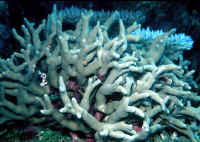 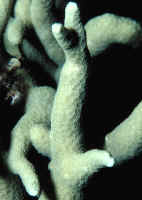
|
Bigger PIX:
The images in this table are linked
to large (desktop size) copies. Click on "framed" images
to go to the larger size. |
|
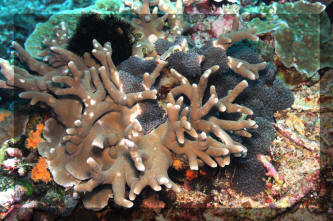
|
| Porites divaricata Thin Finger Coral. To a foot in
height. Thin, long/er stalks than similar P. porites, P. furcata.
Tank to lighter browns. Shallow water. Cozumel 2017 |
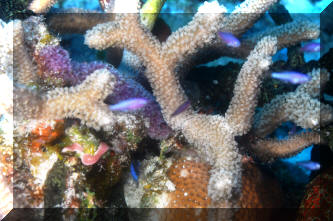
|
| Porites echinulata Klunzinger 1879. Colonies
consist of massive flat top columns. Coenosteum between polyps
elevated, giving a rough appearance. Common in shallow calm water
environments. Red Sea image. |
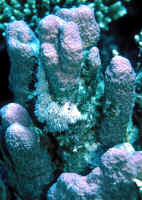
|
| Porites evermanni Vaughan 1907,
Evermann's Coral. A massive form that is sometimes similar to
P. lobata (below), but never yellow in color (is brown to gray
to purple). Commonly knobby and fuzzy at close inspection (the
latter due to partly retracted polyps). Likely endemic to
Hawai'i. Image with P. lobata in background. |
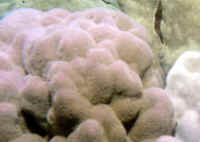 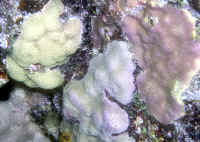
|
Bigger PIX:
The images in this table are linked
to large (desktop size) copies. Click on "framed" images
to go to the larger size. |
|

|
| Porites furcata Branched Finger Coral. Branches
divided into two rounded end lobes on long stalks. Polyps may be randomly
retracted. St. Thomas 2014 |
%20MD.JPG)
|
To: Porites 1, Porites 3,
Porites 4,
|
|

